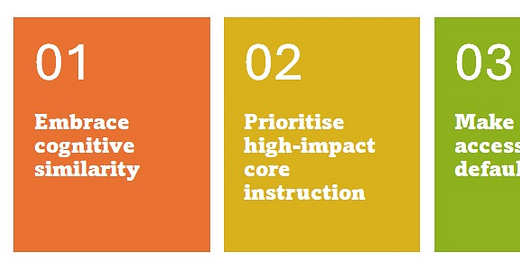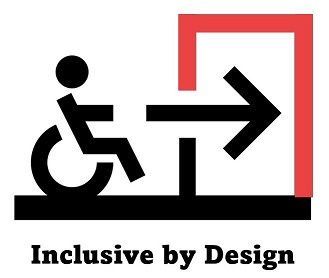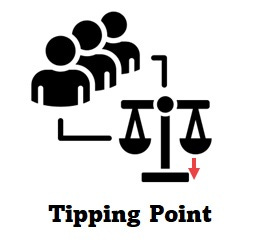When they were mean-spirited teenagers, my wife tells a story of how her best friend managed to break her ankle tripping over a kerb (curb for our American-English speakers out there). They naturally found this very fun - teenagers! No doubt her friend did not.
My point is that the smallest obstacles can be trip hazards for us all.
A dropped-kerb provides an access point from pavement (sidewalk) to road for wheelchair users or those with mobility difficulties. In the UK, we also indicate road crossing points with paving that has small bumps so that those with sight impairments can tell when they are at a safe place to cross the road.
In this post, I will use the dropped-kerb as a metaphor for the idea of making lessons inclusive by design. It is a powerful metaphor because dropped-kerbs are clearly a good thing, we can all empathise with those that have a physical impairment that makes it more difficult to get around, and the dropped-kerb might make life a little less hazardous for all of us.
The dropped-kerb metaphor also gives us an intuitive insight into a paradigm - the social model of disability. The idea is that we should not view disability as being situated with an individual but as being imposed on the individual by the way society is. Viewed through this lens, someone in a wheelchair has an impairment, but is only disabled by the physical infrastructure we have put in place. The argument is that society can be disabling to minority groups but that we can alleviate difficulties if we design our world in more inclusive ways - with the breadth of human difference in mind.
The principle of inclusion by design can be applied to cognitive as well as physical difference and impairment to help us see how we can make the world a more inclusive place. Viewing schools and teaching through this lens will help us identify where more kerbs can be dropped - where barriers to learning can be alleviated in ways which benefit all pupils, but benefit those most disadvantaged in particular.
But why this, and why now? Of all the things we could be doing, why should we make this a priority?
Reason 1: The micro argument
In our annual conference day for subject leaders, we were asked to analyse the content of the ‘Pupil Profiles’ for children with special educational needs from one class. In our school, a Pupil Profile is a short document which sets out information about a child’s special educational needs, what they enjoy, what they find difficult, and what teachers can do to help them. Teachers are expected to read these, internalise the information in them, and adjust their practice accordingly to support individuals.
It is important that we have a mechanism like this for a number of reasons. First, it promotes the child’s voice as they have input into its content. Second, it turns a mountain of information into a digestible format for teachers. Third, it communicates statutory requirements which are set out in EHCPs. Fourth, it provides a focus for regular review and reflection.
We looked at the Pupil Profiles for a KS3 class. 5 students in the class are on the SEND register and therefore have a Pupil Profile (18% of the class).
On each Pupil Profile, there is a section titled ‘It would help me if you could…’ This section provides ‘personalised’ guidance for teachers about how they can help this child in particular, given their needs.
In total, there were 45 things the teacher of this class was being asked to do, an average of 9 per student.
Having counted these, we then looked at the nature of the things teachers were being asked to do to ascertain which, if any, we felt were simply describing effective teaching practice. For example, we judged that “Seat me by a socket for my laptop”, “Excuse me if I am a couple of minutes late. It can take me longer to get around” and “Allow me to finish a sentence - I have a stammer so it takes longer to say what I am thinking” were legitimate, helpful, personalised advice. However, “Give clear instructions”, “Ask questions to dig deeper in my comprehension” and “Prompt me if needed” were firmly in the ‘just good teaching’ camp1.
Of the 45 things teachers are being asked to do, we judged that 20 were describing the things that a good teacher should be doing anyway, 19 were clearly ‘reasonable adjustments’ for an individual need, and the others were arguable either way. In other words, we could roughly half the list if we could be assured that teachers routinely adopted practices that could reasonably be described as good teaching.
Why does this matter? There are at least three reasons:
Dilution of high needs: Some adjustments are more critical than others. Hidden in the 45 suggestions are adjustments for children which are essential to their ability to access the curriculum. We risk overlooking these.
Information overload: Teachers teach multiple classes at secondary level. If the above example is representative of the typical class (in our school it is, and our school is roughly in line with national averages for SEND prevalence), a teacher may be being asked to make hundreds of personalised adjustments. One of our teachers is teaching every KS3 class for Music this year - we estimate that this equates to 700-800 personalised adjustments he is being asked to consider.
Expecting the impossible: Teachers teach classes, not individuals. Whilst some adjustment for individual need is necessary and right, there is a tipping point whereby so many children are classified as in need of personalised provision that the schooling system breaks down.
The micro argument is that if we can make whole-class teaching more inclusive by design, we can substantially reduce the demands of personalised adjustments. This would mean that those who most need these adjustments and personalised in-class support would be more likely to get it. Furthermore, by dropping kerbs in our teaching, we would benefit all pupils because what is good for those who find learning most difficult is also usually good for everyone.
That’s the micro argument. What about the macro?
Reason 2: The macro argument
As classes reach a tipping point when we start to ask for provision to be personalised for a significant proportion of pupils in numerous ways, so too does the schooling system. To understand this argument, we need to distinguish between universal provision and the different or extra provision which has become known as SEND.
Universal provision in education is our core offer, available to all children. This provision should meet most pupils’ needs for most of the time. Where this provision does not meet need, we provide something different or extra. For example, if a pupil falls behind their peers in reading ability we provide additional tutoring, if a child has a hearing impairment we may ask teachers to wear a lanyard which broadcasts their voice to a hearing aid, or if a young person is anxious about attending school we may make temporary adjustments to their timetable and provide additional support.
The provision for different or extra has expanded to an unsustainable level: more children are being defined as having special educational needs than ever before, the number of EHCPs has grown significantly, and there are not enough resources to meet need. This crisis is well documented and and this recently published paper by Steplab provides more detail if you are interested. For the purpose of this post, the key point is that universal provision must meet needs better so that we can focus the resources we have available for different or extra on the pupils who have the highest needs. There are four reasons why:
Affordability: There is no more cash right now.
Efficiency: Universal provision is a more efficient way of meeting low to moderate need than provision which exists to compensate for the shortfalls in quality of the core offer.
Social justice: The resources which are available should be prioritised for those with the highest need, whilst those with low to moderate need should be better serviced by universal provision.
Stigma: We should seek to minimise the need for ‘special’ provision and normalise difference.
The macro argument is that the more we can meet low to moderate need through universal provision the more we can focus scarce resources on meeting more profound needs which require something different or extra. Furthermore, by improving the inclusiveness of the universal provision we will bring benefits to all pupils, with or without additional needs.
The principles of inclusive teaching
In a landmark paper, Mccrea et al2 set out 5 principles for inclusive teaching, as follows:
I would strongly suggest reading the paper. It makes a compelling argument for ‘dropping kerbs’ and provides practical suggestions for how to do this. I would like to reflect on four things that struck me as I read the paper.
Cognitive overload
Our limited working memories are a kerb we all trip over and cognitive load is a concept that applies in multiple ways when considering inclusivity. Cognitive load helps explain why schools which are calm, orderly and predictable are preferable to those that are noisy, chaotic and unpredictable. It helps explain why pupils struggle to pay attention, concentrate or follow instructions. It shines a light on PowerPoint slides and worksheets that are cluttered and unreadable, on how pupils’ attention can be split between graphic and text, image and voice. Cognitive load sits behind the ‘just good teaching’ suggestions in our Pupil Profiles - clear instructions, breaking down content, providing scaffolding, checking for understanding, take-up time, silent working.
Mccrea et al suggest we make lessons:
Perceivable
Understandable
Doable
Cognitive similarity
There is more that unites us than that distinguishes us when it comes to learning. Lesson design should build on cognitive similarities first and foremost. Mccrea et al argue that this does not mean ignoring individual difference, rather “it allows us to design core instruction that is effective for the widest possible range of students from the start”. By doing so, we minimise the need for individual adaptation and ensure that the load of teachers’ working memory is also manageable.
How does this fit with the concept of differentiation? I have heard people say that inclusive teaching or adaptive teaching are just a new name for differentiation. They are not. Differentiation is ‘different or extra’ - the adjusted worksheet, alternative task, or lowered expectation. Inclusive teaching is making whole class instruction meet needs as far as possible, without the need for teachers making special provision. I have also heard teachers say that ‘we no longer need to differentiate’. This is also not true. Children with high needs in mainstream classes may need the curriculum, resources or supported specially tailored to make learning accessible, but we cannot expect teachers to do this for every child on the special needs register.
Barriers over labels
Some children find background noise more distracting than others. Some find social situations more difficult to navigate. Some can hold less information in their working memory than others. Some will struggle to comprehend written information which most in the class can get a handle on. Some experience stronger emotions when confronted with challenging tasks than others. Some cannot see the board if they are sitting too far away.
Some children will be given labels to describe them: ASD, ADHD, depression, dyslexia, short sightedness… and so on. These labels may serve a purpose medically, socially, emotionally or in accessing resources. They may also have some educational value in helping us work out what the barriers are to learning. However, it is the barrier, the difficulty, in relation to learning, rather than the label or diagnosis, that should be foregrounded. These difficulties are not the preserve of those with a diagnosis, an EHCP, or who are on the SEN register. Many exist to some extent in all of us. This idea is central to the principle of dropped-kerbs: there are not children with needs and children without. Whilst some of us may experience barriers to learning more acutely, learning is difficult for everyone to some extent. Normalising learning difficulty as inherent to all of us may help reduce the stigma of special needs. And placing need in the foreground, leaving labels blurred behind, is likely to help us better meet need.
Inclusive teaching considers universal learning difficulties and foregrounds learning barriers over labels, whilst recognising that these barriers can be more acute and specific for some children.
Responsiveness
Mccrea et al argue that the Plan-Do-Review cycle, the bureaucratic SEN review process which sits at the heart of the graduated response to children’s needs, should be adopted as a principle by teachers as an ongoing process of information gathering and responsive practice. This, they argue’ ‘relies on high-frequency, whole-class checking for understanding woven into the lesson’.
This concept, also known as adaptive teaching, is inclusive by design as it builds in a higher chance that teachers will identify misconceptions and weak comprehension at an early stage, providing an opportunity to address these at an early stage. High ratio techniques are required for real-time feedback loops to become the norm.
Being adaptive is just good teaching. It means we are spotting the trip-hazards and adjusting our practice in real-time to get everyone safely across the road.
What we can surmise is that dropping the kerb means taking action to manage cognitive load, designing lessons with an understanding of how humans learn, considering carefully the universal barriers to learning and how these will be overcome, foregrounding need over label, and seeking frequent, whole-class feedback to ensure our teaching continues to be responsive to the emerging needs of pupils as the lesson progresses. Doing so will help meet low to moderate learning needs and be beneficial for all pupils. It will also mean that valuable time, effort and attention by teachers can be put towards providing reasonable adjustments and individual support for those with highest need.
The challenge ahead is to improve the quality of universal provision such that the demand for different and extra comes back down to a manageable level. This is no easy task, but we can make things better for all by making teaching inclusive by design.
None of this is a criticism of the people who have put together the Pupil Profiles. They have done exactly what we have asked them to do.
Mccrea, Barker & Goodrich (2025), Inclusive Teaching - A Discussion Paper









